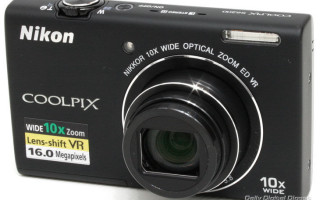Nikon Coolpix S6200 - triple ultra?
Nikon Coolpix S6200 - triple ultra?
Externally, the camera attracts the eye, and the specifications promise absolutely magical capabilities at a not very high price - it would seem, what else does the average user need? The Nikon Coolpix S6200 is just such a camera, but we recommend reading this review, in which we will talk about the many nuances identified during the testing process
"Ultra" in a cube. This is exactly how you can characterize the new Nikon Coolpix S6200 when looking at the characteristics. After all, this is an ultra-thin ultra-compact ultrazoom - the camera is equipped with a lens with 10x zoom (25-250 mm equivalent for 35 mm cameras) in a small body with a thickness of only 25.4 mm. At the same time, the price does not bite - it starts at 5,550 rubles, which is still slightly higher than that of direct competitors, of which, to put it mildly, there are few: these are the Fujifilm Finepix T200 and Olympus VR-320, which we have already tested .
The camera does not differ in any significant way from its competitors. The only things that catch your eye are the HDMI port, the ability to record video with stereo sound and 16 megapixels, squeezed out from a 1/2.3-inch CCD matrix, while competitors are content with 14 megapixels, although, however, this is too much. Of course, a greater number of points of gain does not provide any gain at all, so the main thing is how the camera will perform in operation - how fast, how accurate it is, how loud the sensor is, how long it works on one charge, which we will consider in this material.
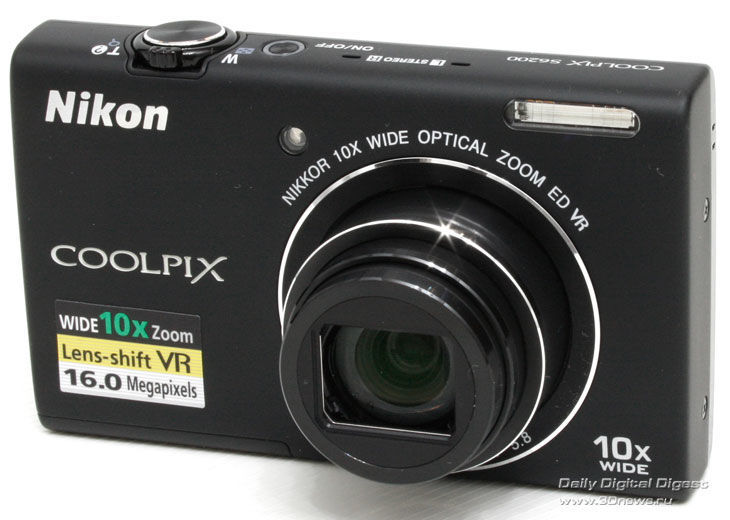
Technical characteristics declared by the manufacturer
| Nikon Coolpix S6200 | |
|---|---|
| Image sensor | CCD, 1/2.3-inch |
| Effective number of points, MP | 16 |
| Image saving format | Still image: JPEG (EXIF 2.3, DCF) Video: MPEG4 |
| Frame size in pixels | Photo frame: 4608x3456, 4000x3000, 3264x2448, 2592x1944, 2048x1536, 1024x768, 640x480, 4608x2592 Video: 720p: 1280x720 (30 frames per second) iFrame 540: 96 0x540 (30fps) VGA: 640x480 (30fps per second) |
| DPOF | DPOF support |
| Sensitivity | ISO 80, 100, 200, 400, 800, 1600, 3200 (4608×3456), auto (ISO 8-1600), range-lock auto (ISO 80-400, ISO 80-800) |
| Lens design | 8 elements in 8 groups (1 ED glass element) |
| Focal length, mm | 4.5-45 (35mm format equivalent: 25-250) |
| Diaphragm | ƒ/3.2-5.8 |
| Digital zoom | Maximum magnification: 4x (35mm format equivalent: approx. 1000mm) |
| Focus range | Normal Mode: 50cm to Infinity (Wide Angle) 1.1m to Infinity (Telephoto) Macro Mode: Approx. from 10 cm to infinity (at extreme wide-angle position) |
| Exposure, s | 1-1/2000 Fireworks mode - 4 |
| Exposure metering | 256-segment matrix, center-weighted (with digital zoom 2x) Spot (with digital zoom 2x or more) |
| Exposure compensation | +/-2 EV in 1/3 EV increments |
| Scene modes | 18 story programs |
| White balance | Auto, 5 preset modes, manual |
| Built-in flash | Eat |
| Flash Modes | Automatic, Forced trigger, Low-speed sync, Red-eye reduction |
| Flash range (sensitivity Auto), m | Normal mode Wide angle: 0.5-4.6 Tele position: 0.5-3.0 |
| Self-timer | With 2/10 s delay |
| Storage device | SD/SDHC/SDXC/UHS-I |
| LCD display | 6.7 cm (2.7″), resolution 230 thousand dots |
| Interface | USB 2.0, AV-out, HDMI |
| Nutrition | Lithium-ion battery EN-EL12 3.9 Wh |
| Dimensions, mm | 93×56,7×25,4 |
| Weight, g | 160 |
Representatives of the Nikon company are not particularly eager to provide introductory and especially engineering samples for testing, arguing that many of the shortcomings of the engineering samples will still be corrected in the commercial samples, so it was the latter that was provided for testing, even with a warranty card. The following was found in its delivery kit:
- camera strap AN-CP19,
- lithium-ion battery EN-EL12,
- AC charger EH-69P,
- ViewNX 2 software CD,
- CD with an electronic version of the complete manual,
- several information brochures.
Appearance and ease of use
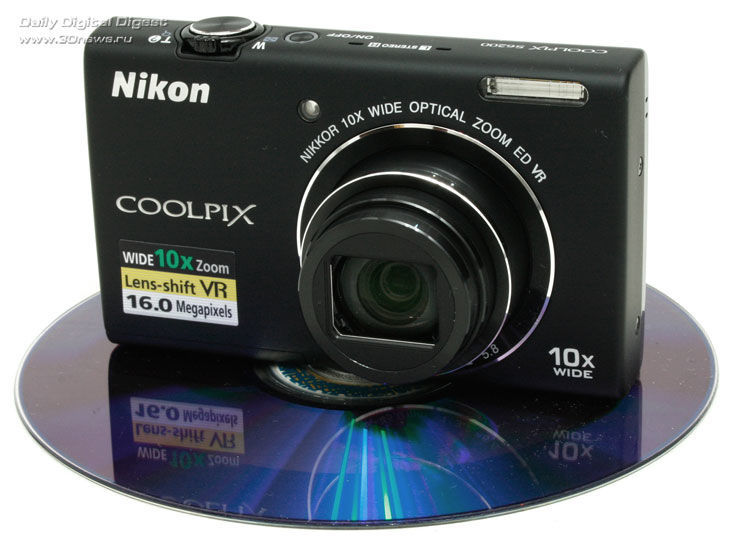
General view. Lens in SHU position
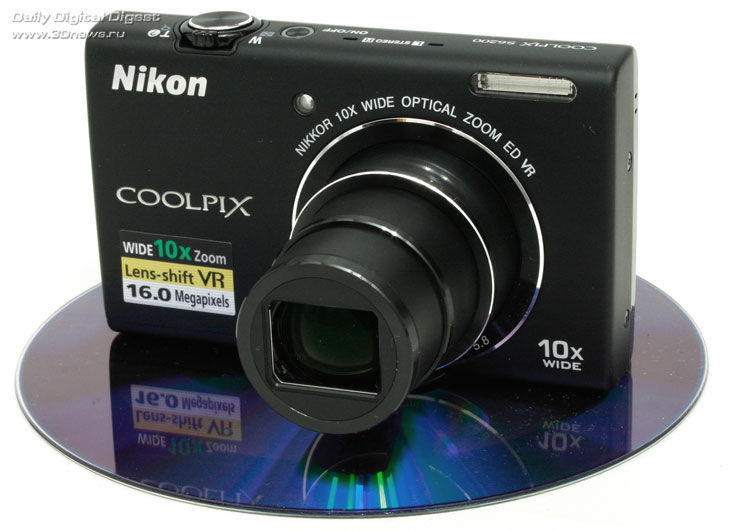
General view. Lens in telephoto position
Formally, the camera is the thinnest among ultrasonics - only 25.4 mm, but in fairness it is worth noting that the Fujifilm FinePix T200 camera, if you do not take into account the protruding parts, is much thinner - only 18.8 mm, but such a magnificent result is spoiled by the protruding lens, whereas the shape of the camera under test resembles a brick - nothing sticks out anywhere.
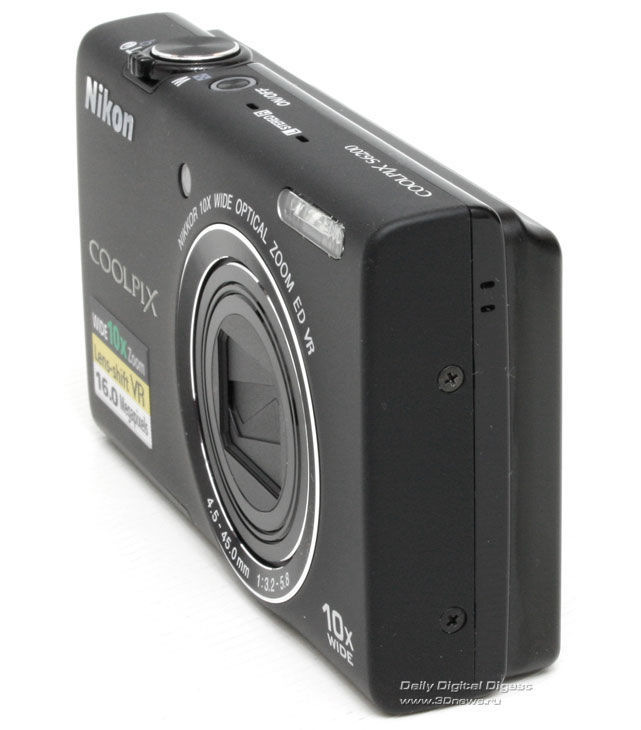
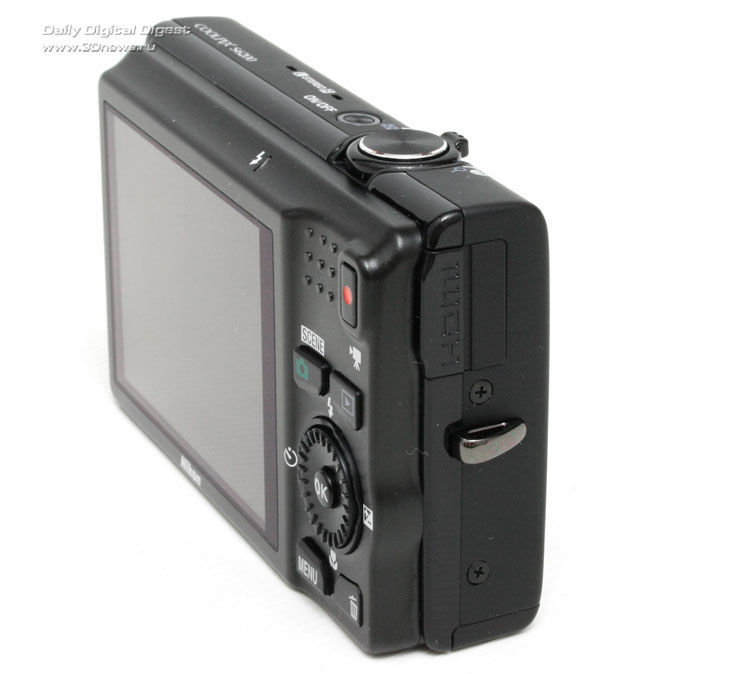
The material of the body panels is metal, but the back side is covered with matte paint, and the front side sports a soft touch coating. This type of coating does a good job of hiding fingerprints even on a black body (on lighter panels, fingerprints are completely invisible), and those that are visible can simply be wiped off without the help of a cloth. In addition, this coating is pleasant to the touch, and the camera does not slip out of your hands. The build quality is excellent: when you try to twist and squeeze, the case does not give in and does not make any sounds. But there are also disadvantages - the battery cover does not always fit into the grooves. It seems like a small thing, but if you frequently remove the memory card, it’s a little annoying.
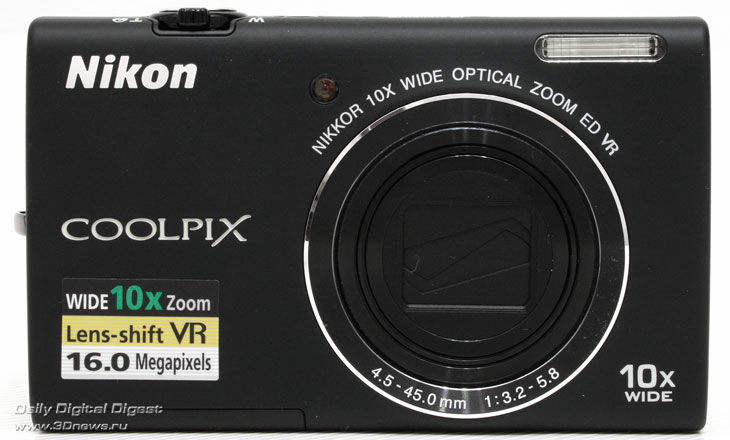
On the front there is a lens, a flash window and an auto-shutter timer indicator, which also doubles as an AF-assist lamp.
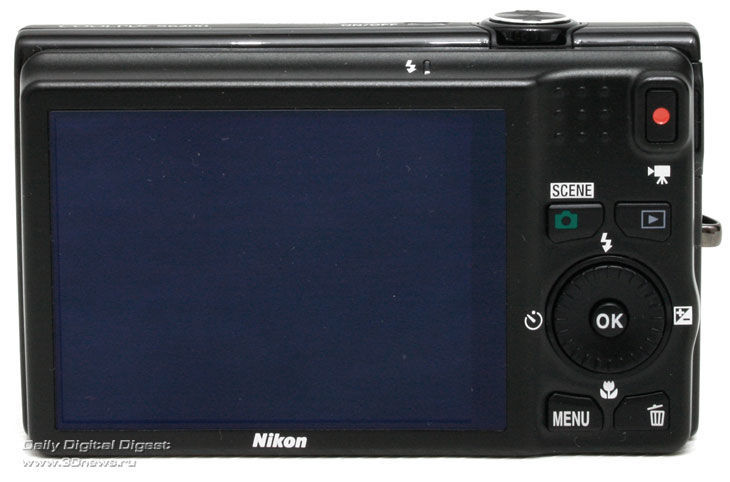
The back side of the new product is very similar to other compacts of the S series - there is a screen, to the right of which there is a video key, buttons for selecting the shooting mode and switching to playback mode, a round rotating 4-way multifunction key with an enter button in the center, as well as keys for entering the main menu and removal.
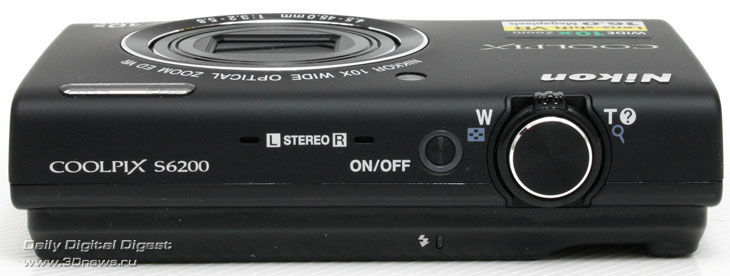
On top there is a pair of microphones, a power button, and a shutter key with a zoom control lever.
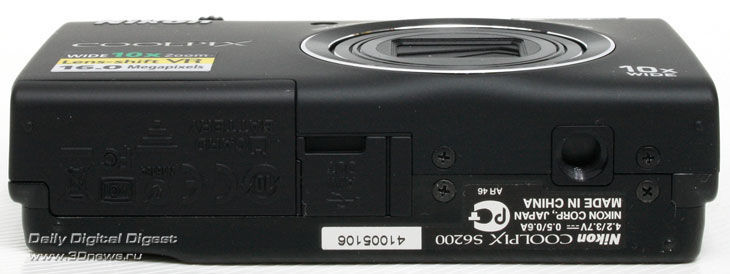
From below, at first glance, only the tripod mounting connector and the battery compartment cover are noticeable, but right there under the rubber plug there is also a single connection connector for USB and AV cables.
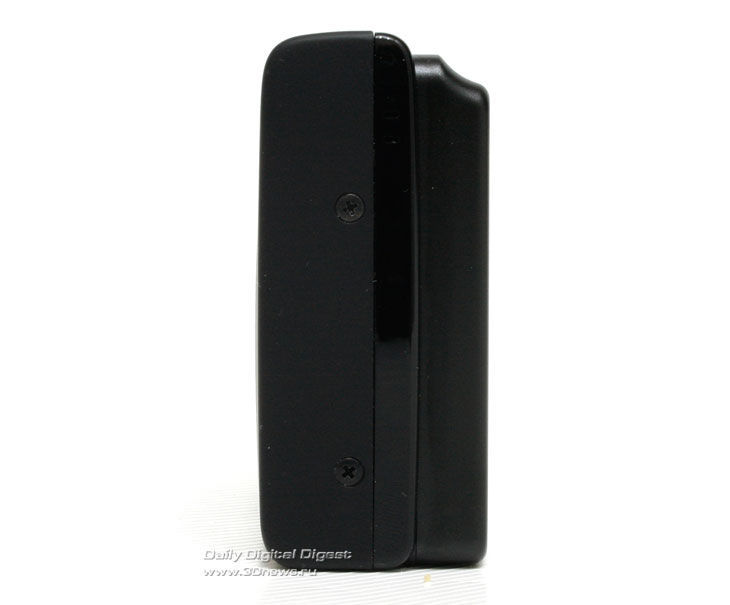
On the left is only the hole for the system speaker, and on the right is the eyelet for the fastening cord and the HDMI cable connection port, hidden by a rubber plug.
Nikon Coolpix S6200 - triple ultra?
Sergey Verveyko
| November 03, 2011 |
"Ultra" in a cube. This is exactly how you can characterize the new Nikon Coolpix S6200 when looking at the characteristics. After all, this is an ultra-thin ultra-compact ultrazoom - the camera is equipped with a lens with 10x zoom (25-250 mm equivalent for 35 mm cameras) in a small body with a thickness of only 25.4 mm. At the same time, the price does not bite - it starts at 5,550 rubles, which is still slightly higher than that of direct competitors, of which, to put it mildly, there are few: these are the Fujifilm Finepix T200 and Olympus VR-320, which we have already tested .
The camera does not differ in any significant way from its competitors. The only things that catch your eye are the HDMI port, the ability to record video with stereo sound and 16 megapixels, squeezed out from a 1/2.3-inch CCD matrix, while competitors are content with 14 megapixels, although, however, this is too much. Of course, a greater number of points of gain does not provide any gain at all, so the main thing is how the camera will perform in operation - how fast, how accurate it is, how loud the sensor is, how long it works on one charge, which we will consider in this material.

⇡#Technical characteristics declared by the manufacturer
| Nikon Coolpix S6200 | |
|---|---|
| Image sensor | CCD, 1/2.3-inch |
| Effective number of points, MP | 16 |
| Image saving format | Still image: JPEG (EXIF 2.3, DCF) Video: MPEG4 |
| Frame size in pixels | Photo frame: 4608x3456, 4000x3000, 3264x2448, 2592x1944, 2048x1536, 1024x768, 640x480, 4608x2592 Video: 720p: 1280x720 (30 frames per second) iFrame 540: 96 0x540 (30fps) VGA: 640x480 (30fps per second) |
| DPOF | DPOF support |
| Sensitivity | ISO 80, 100, 200, 400, 800, 1600, 3200 (4608×3456), auto (ISO 8-1600), range-lock auto (ISO 80-400, ISO 80-800) |
| Lens design | 8 elements in 8 groups (1 ED glass element) |
| Focal length, mm |
4.5-45 (35mm format equivalent: 25-250) |
| Diaphragm | ƒ/3.2-5.8 |
| Digital zoom | Maximum magnification: 4x (35mm format equivalent: approx. 1000mm) |
| Focus range | Normal Mode: 50cm to Infinity (Wide Angle) 1.1m to Infinity (Telephoto) Macro Mode: Approx. from 10 cm to infinity (at extreme wide-angle position) |
| Exposure, s | 1-1/2000 Fireworks mode - 4 |
| Exposure metering | 256-segment matrix, center-weighted (with digital zoom 2x) Spot (with digital zoom 2x or more) |
| Exposure compensation | +/-2 EV in 1/3 EV increments |
| Scene modes | 18 story programs |
| White balance | Auto, 5 preset modes, manual |
| Built-in flash | Eat |
| Flash Modes | Automatic, Forced trigger, Low-speed sync, Red-eye reduction |
| Flash range (sensitivity Auto), m | Normal mode Wide angle: 0.5-4.6 Tele position: 0.5-3.0 |
| Self-timer | With 2/10 s delay |
| Storage device | SD/SDHC/SDXC/UHS-I |
| LCD display | 6.7 cm (2.7″), resolution 230 thousand dots |
| Interface | USB 2.0, AV-out, HDMI |
| Nutrition | Lithium-ion battery EN-EL12 3.9 Wh |
| Dimensions, mm | 93×56,7×25,4 |
| Weight, g | 160 |
⇡#Supply set
Representatives of the Nikon company are not particularly eager to provide introductory and especially engineering samples for testing, arguing that many of the shortcomings of the engineering samples will still be corrected in the commercial samples, so it was the latter that was provided for testing, even with a warranty card. The following was found in its delivery kit:
- camera strap AN-CP19,
- lithium-ion battery EN-EL12,
- AC charger EH-69P,
- ViewNX 2 software CD,
- CD with an electronic version of the complete manual,
- several information brochures.
⇡#Appearance and ease of use

General view. Lens in SHU position

General view. Lens in telephoto position
Formally, the camera is the thinnest among ultrasonics - only 25.4 mm, but in fairness it is worth noting that the Fujifilm FinePix T200 camera, if you do not take into account the protruding parts, is much thinner - only 18.8 mm, but such a magnificent result is spoiled by the protruding lens, whereas the shape of the camera under test resembles a brick - nothing sticks out anywhere.


The material of the body panels is metal, but the back side is covered with matte paint, and the front side sports a soft touch coating. This type of coating does a good job of hiding fingerprints even on a black body (on lighter panels, fingerprints are completely invisible), and those that are visible can simply be wiped off without the help of a cloth. In addition, this coating is pleasant to the touch, and the camera does not slip out of your hands. The build quality is excellent: when you try to twist and squeeze, the case does not give in and does not make any sounds. But there are also disadvantages - the battery cover does not always fit into the grooves. It seems like a small thing, but if you frequently remove the memory card, it’s a little annoying.

On the front there is a lens, a flash window and an auto-shutter timer indicator, which also doubles as an AF-assist lamp.

The back side of the new product is very similar to other compacts of the S series - there is a screen, to the right of which there is a video key, buttons for selecting the shooting mode and switching to playback mode, a round rotating 4-way multifunction key with an enter button in the center, as well as keys for entering the main menu and removal.

On top there is a pair of microphones, a power button, and a shutter key with a zoom control lever.

From below, at first glance, only the tripod mounting connector and the battery compartment cover are noticeable, but right there under the rubber plug there is also a single connection connector for USB and AV cables.

On the left is only the hole for the system speaker, and on the right is the eyelet for the fastening cord and the HDMI cable connection port, hidden by a rubber plug.
Nikon Coolpix S6200

- Autofocus type: contrast
- Digital Zoom: 4x
- Optical Zoom: 10x
- Focal length: 25 - 250 mm
- Aperture: F3.2 - F5.8
- Number of effective megapixels of the matrix: 16 million
- Physical matrix size: 1/2.3″ null,1,”11218
- Matrix type: CCD
- Number of megapixels of the matrix: 16.44 million
- Sensitivity: 80 - 1600 ISO, Auto ISO
Here you can watch a video review of the Nikon Coolpix S6200. Find out the characteristics, read reviews about the Nikon Coolpix S6200.
Stores where you can buy this product and its analogues
Video reviews Nikon Coolpix S6200
- All 68
- Reviews 14
- Unboxing 4
- Repair 2
- Tests 10
- Reviews 10
 The Moon in my telescope, first astro photography, on Nikon Coolpix S6200
The Moon in my telescope, first astro photography, on Nikon Coolpix S6200
Specifications Nikon Coolpix S6200
* Check with the seller for exact specifications.
Lens
| Autofocus type | contrasting |
| Autofocus illuminator | There is |
| Digital Zoom | 4x |
| Optical Zoom | 10x |
| Focal length | 25 - 250 mm |
| Diaphragm | F3.2 - F5.8 |
Matrix
| Number of effective megapixels of the matrix | 16 million |
| Physical matrix size | 1/2.3″ null,1,”11218 |
| Matrix type | CCD |
| Number of megapixels of the matrix | 16.44 million |
| Sensitivity | 80 - 1600 ISO, Auto ISO |
Viewfinder and screen
| LCD screen | 230000 dots, 2.70 inches |
| Using the screen as a viewfinder | There is |
| Viewfinder type | absent |
Excerpt
| Manual shutter speed and aperture settings | No |
Light control
| Exposure compensation | +/- 2 EV in 1/3 stop increments |
White balance
| White balance | automatic, manual installation, from the list |
Flash
| Flash | built-in, red-eye reduction |
Video and sound recording
| Max. video resolution | 1280×720 |
| Video recording | There is |
| Sound recording | There is |
| Video recording format | MOV |
Interfaces and memory
| Built-in memory size | 74 MB |
| Memory card type | SD, SDHC |
| Image formats | JPEG |
| Interfaces | USB 2.0, video, HDMI, audio |
Shooting speed and modes
| Timer | There is |
| Macro photography | There is |
| Frame format (still photography) | 4:3 |
Nutrition
| Battery capacity | 1050 mAh or 250 photos |
| Number of batteries | 1 |
| Battery type | your own |
Dimensions
| Weight (without batteries) | 160 g, with batteries |
| Size | 93x57x25 mm |
Additional Information
| Camera type | compact |
| Sales start date | 2011-09-15 |
| Announcement date | 2011-08-24 |
| Additional features | tripod mount |
* Check with the seller for exact specifications.
Pros and cons of Nikon Coolpix S6200
Price, focal length range, choice of ISO values within the specified limits 80-400, 80-800. good photo quality compared to others in this price category
1.Good zoom. I really don't recommend using digital. 2.Shooting clarity. Some will say that it is not the best, but for a soap dish it is very good. You can take good pictures, although sometimes not the first time. 3.Convenient location of buttons. 4.Nice design. 5. “Non-seize” lids. 6.A variety of shooting modes, typical for other Nikon cameras. 7.Dimensions and weight. You can carry it in your pocket, but personally I preferred the case. 8.Autofocus.
There is manual focusing. Wide angle.
Design, good package, price, video quality, outstanding night photography, excellent flash, sunset mode
The pictures are good, built-in ability to enlarge and crop videos, display date and time on photos, good quality video
The design and materials of the case are pleasant to hold in your hands.
1. Small size, fits comfortably in your hand. 2. Many scene programs that the camera can automatically select depending on the shooting conditions and scene. At the same time, he often makes no mistakes in choosing a scene. 3. Capacious battery, can be charged from a USB port. 4. When connected to a computer via the supplied cable, you don’t have to turn on the camera, the flash drive is “visible”, and you don’t need to install proprietary software for downloading captured photos and videos with specifying the folder where to dump them (W 7)
Reliability, good picture quality. A powerful battery, if you don’t remove it often, lasts for six months without recharging.
Very nice design, fits comfortably in the hand, does not slip. I especially liked the presence of the navigation wheel - a very convenient thing 🙂 It’s a pleasure to operate it!
Photo quality. I have been using a DSLR with a Tamron lens for a year now, and for those who are considering a holivar, I can immediately say that I have tried all possible modes and settings on my camera. This is the second day I’ve been using this camera, and the quality of the photos is just a balm for the soul. There are many modes, but for me this is not so important.
There is distortion at wide angles, and loss of sharpness at telephoto.
1.The edges of the photo are slightly blurred, but who is looking there?
(As a last resort, you can trim it in the editor). 2. Of course, the clarity of shooting is poor compared to DSLRs, but, as I already said, good pictures can be taken.
3.The screen ripples a little during shooting, but this does not affect the result of the photo.
Price. Low lens sensitivity (3.2-5.8) Focuses terribly and slowly. Focusing from 10 cm, and therefore macro is not macro at all.
Macro photography, weight, very strong blurriness when moving the lens in any way.
lens noise when shooting video, when you zoom in on an object, with optical zoom up to 9-10x, blurring of the frame, many settings of which need to be studied.
The edges of the photo are really blurry, it distorts greatly, it stretches everything in the corners, and if your face is close to the edges, it’s absolutely terrible, scary to look at - this is perhaps the main drawback.
but as the pros say, this is normal for a wide angle.
The display does not show how close the zoom is. it's just a stripe moving.
1. Autofocus is not very fast and often makes mistakes.
2. The video has HD resolution but the quality is not very good (a little unclear) especially when zoomed in.
3. Optical zoom is 10x, but the photo quality at maximum optical zoom is noticeably poor
4. Passable photos are obtained only in good lighting (outdoors during the day)
distortion of images due to wide angle, but this can be avoided by shooting from afar and zooming in. It takes a long time to take a photo of the next frame and it slows down when shooting. The object is already in a different place, but it gives out the frame.
In a month of use, there were no such ones.
After a DSLR, the lack of full customizability is unusual - you can’t adjust the aperture and shutter speed. Although he takes decent photographs anyway.
Digital Compact Camera Nikon COOLPIX S6200
A high-performance model with an effective pixel count of 16.0-million pixels for superior image quality and equipped with a 10x optical zoom NIKKOR lens, all in one of the most compact bodies in its class
TOKYO-Nikon Corporation is pleased to announce the release of the high-performance S6200, a 10x optical zoom COOLPIX S-series model incorporating advanced functions in a refined design.
The S6200 is a stylish model that, despite being equipped with a 10x optical zoom NIKKOR lens, has a slim, compact and elegant body. In addition to offering excellent basic performance with superior image quality and high-speed response, the S6100 is equipped with four features—less noise at high sensitivities, Motion detection function, lens-shift vibration reduction (VR) function, flash control system—that enable capture of beautiful nighttime shots. The S6200 is also equipped with a hand-held/tripod night landscape detection function that enables it to automatically distinguish between hand-held shooting and shooting with the camera mounted on a tripod to provide the optimal response to shooting conditions regardless of lighting levels, making successful capture of blur-free night landscapes even easier. What's more, Special effects mode for shooting and Filter effects for editing photos already taken allow you to create artistic photos and movies never before possible.
COOLPIX S6200 Primary Features
1. An effective pixel count of 16.0-million pixels and a 10x optical zoom NIKKOR lens with a zoom range beginning at the w >10x optical zoom and one of the smallest bodies in its class were made possible by making the most of an exclusive new , high-density slim lens barrel design. The S6200 achieves a size that makes it easy to take with you wherever you go, and coverage for a broad range of angles of view, from wide-angle to telephoto, making it possible for anyone to easily capture beautiful photos.
3. Equipped with 4 technologies and a hand-held/tripod night landscape detection function that enable capture of beautiful nighttime shots in difficult dimly lit or dark surroundings
4. Shooting, playback and retouch functions that easily enable the creation of artistic works: Special effects, Filter effects
Special Effects are applied with shooting of still images or recording of movies to create delicate images or those with impact through the adjustment of colors and/or contrast prior to recording. Filter Effects are easily applied to still images and movies that have already been recorded. These two features enable simple creation of fun, original images, expanding the ways in which you express yourself.
Special Effects Special effects can be applied prior to shooting, enabling users to capture photos with colors and tones that suit their intent. Soft, High key, Low key, Nostalgic sepia, High-contrast monochrome and Selective color options are available. Filter Effects Easily apply filter effects to photos already taken without using a computer. Cross screen, Fisheye, Miniature effect, Painting, Soft and Selective color options are available.
5. High-speed response that ensures certain capture of fleeting scenes
With an autofocusing time of approximately 0.28 and a shooting time lag of approximately 0.42 s, the camera responds immediately to sudden photo opportunities and moving subjects. The S6200 never misses once-in-a-lifetime shots.
-
Autofocusing time and shooting time lag measured according to Nikon standards: 25mm focal length (equivalent in 35mm [135] format), shooting distance of 2 m, ambient brightness of LV 10; images to recorded 4-GB >Adoption of a rotary multi selector enables nimble and easy operation. In addition, a simple, yet refined and elegant design has been achieved with the S6200 by designing it with consideration of the optimal position and size of buttons and other controls, as well as through the coordination of body and lens barrel color.
Nikon COOLPIX S6200 Specifications
| Effective pixels | 16.0million |
|---|---|
| Image sensor | 1/2.3-in. type CCD; total pixels: approx. 16.44 million |
| Lens | 10x optical zoom, NIKKOR lens 4.5-45.0mm (angle of view equivalent to that of 25-250 mm lens in 35mm [135] format) f/3.2-5.8; Digital zoom Up to 4x (angle of view equivalent to that of approx. 1000 mm lens in 35mm [135] format) |
| Focus range(from lens) | [W]: Approx. 50 cm to ∞, [T]: Approx. 1.0 m to ∞, Macro mode: Approx. 10 cm to ∞ ( wide-angle position ) |
| Monitor | 6.7 cm (2.7-in.), approx. 230k-dot, TFT LCD with anti-reflection coating and 5-level brightness adjustment |
| Storage media | Internal memory (approx. 74 MB), SD/SDHC/SDXC memory card |
| ISO sensitivity | ISO 80, 100, 200, 400, 800, 1600, 3200 Auto (auto gain from ISO 80 to 1600) Fixed range auto (ISO 80 to 400, 80 to 800) |
| Interface | Hi-Speed USB |
| HDMI output | Can be selected from Auto, 480p, 720p, and 1080i |
| Power sources | One Rechargeable Li-ion Battery EN-EL12 (supplied) AC Adapter EH-62F (available separately) |
| Battery life(EN-EL19) | Still pictures* 1 : Approx. 250 shots Movies: Approx. 1h 40 min (HD 720p). The maximum file size for a single movie is 4 GB and the maximum movie length for a single movie is 29 minutes, even when there is sufficient free space on the memory card for longer recording. |
| Dimensions(WxHxD) | Approx. 93.0 x 56.7 x 25.4 mm |
| Weight | Approx. 160 g (including battery and SD memory card) |
| Supplied accessories* 2 | Camera Strap, Rechargeable Li-ion Battery EN-EL12, Charging AC Adapter EH-69P, USB Cable UC-E6, Audio Video Cable EG-CP16, ViewNX 2 CD-ROM |
- Unless otherwise stated, all figures are for a camera with a fully-charged Rechargeable Li-ion Battery EN-EL12 operated at an ambient temperature of 25 °C (77 °F).
- *1 Based on Camera and Imaging Products Association (CIPA) standards for measuring the life of camera batteries.
- *2 Supplied accessories may differ by country or area.
For more information
The information is current as of the date of publication. It is subject to change without notice.
Nikon Coolpix S6200 Silver










Instructions and files
| File | Pages | Format | Size | Action |
 |
To read the instructions, select the file in the list that you want to download, click on the “Download” button and you will be redirected to a page where you will need to enter the code from the image. If the answer is correct, a button to receive the file will appear in place of the picture.
If there is a “View” button in the file field, this means that you can view the instructions online, without having to download it to your computer.
If you think the material is not complete or you need additional information on this device, for example a driver, additional files, such as firmware or firmware, then you can ask a question to the moderators and members of our community, who will try to quickly respond to your question.
You can also view instructions on your Android device
Short description
It's ideal for those who don't know what tomorrow will bring them, but don't want to miss the slightest detail - the NIKKOR lens with 10x zoom will allow you to capture any scene: from natural portraits to clear shots of a musical group, in which absolutely everyone is clearly visible those present.
- Ultra-compact with impressive zoom
— CCD matrix with a resolution of 16 megapixels
— NIKKOR zoom lens with 10x magnification
— Possibility of wide-angle shooting
— HD video recording (720p) with stereo sound
A slim and stylish camera with an impressive zoom: in bright, colorful bodies that fit even in your pocket.
The 16-megapixel CCD sensor allows you to capture incredibly detailed images, create artistic cropping, and create amazingly sharp, poster-sized blowups of your images.
The NIKKOR 10x zoom lens with wide-angle capability delivers stunning detail and high resolution (35mm format equivalent: 25-250mm).
Anti-blur technology automatically reduces blur in images in four different ways. Lens-shift VR (Vibration Reduction) reduces the effects of camera shake. High light sensitivity (up to ISO 3200) reduces the likelihood of image blur when shooting fast-moving subjects or in low-light conditions. Best Shot Selector (BSS) automatically finds the sharpest shot out of 10 consecutive shots. Night Landscape mode lets you capture sharp images in low-light conditions.
6.7 cm diagonal 230K dot LCD monitor delivers vibrant colors, sharp contrast and clear viewing. Nikon's pure color monitor technology minimizes glare, even in bright sunlight.
HD (720p) video recording with stereo sound: Optical zoom and autofocus are available during recording, and you can also take a photo while shooting video. The camera has a built-in HDMI connector that supports HDMI-CEC, allowing you to connect it to an HDTV.
Fast Response: Fast start-up and autofocus let you capture events the moment they happen.
Special Effects: Let you take photos or videos with a special effect, or use the built-in filter to edit your photos after shooting. You can shoot using effects such as Soft Filter and Nostalgic Sepia, with a preview of the results of their application on the LCD monitor. You can use filters such as Rays, Fisheye, and Miniature.
The EXPEED C2 image processing system provides advanced movie recording capabilities, high sensitivity and maximum image quality.
Smart Portrait System: Advanced automatic features to capture perfect portraits. Smile Timer takes a photo when the selected subject smiles. Blink detection alerts you when your subject's eyes are closed. Skin softening adjusts for uneven skin tones on the subject's face, making skin appear smoother. Built-in red-eye reduction eliminates red-eye that occurs when using the flash while shooting.
18 scene modes automatically set optimal settings for common shooting styles, effects and locations.
Scene auto selector finds the optimal scene mode for the most common photography conditions.
Nikon Coolpix S6200 vs. Nikon Coolpix S3500
Comparison
 |
 |
Sensor
Sensor size is generally a good indicator of the quality of the camera. Sensors can vary greatly in size. As a general rule, the bigger the sensor, the better the image quality.
Bigger sensors are more effective because they have more surface area to capture light. An important factor when comparing digital cameras is also camera generation. Generally, newer sensors will outperform the older ones.
Actual sensor size
1 : 1 (ratio) Nikon Coolpix S6200 Nikon Coolpix S3500| 28.46 mm² | vs | 28.46 mm² |
Pixel pitch tells you the distance from the center of one pixel (photosite) to the center of the next. It tells you how close the pixels are to each other.
The bigger the pixel pitch, the further apart they are and the bigger each pixel is. Bigger pixels tend to have better signal to noise ratio and greater dynamic range.
Pixel or photosite area affects how much light per pixel can be gathered. The larger it is the more light can be collected by a single pixel.
Larger pixels have the potential to collect more photons, resulting in greater dynamic range, while smaller pixels provide higher resolutions (more detail) for a given sensor size.
Pixel density tells you how many million pixels fit or would fit in one square cm of the sensor.
Higher pixel density means smaller pixels and lower pixel density means larger pixels.
Specs
Choose cameras to compare
Popular comparisons:
Diagonal
Diagonal is calculated by the use of Pythagorean theorem:
| Diagonal = √ | |||
| Diagonal = √ | |||
| Diagonal = √ | Pixel pitch = | sensor width in mm | × 1000 |
| sensor resolution width in pixels |
S6200 pixel pitch
Sensor w > Sensor resolution w >
| Pixel pitch = | 6.16 | × 1000 | = 1.34 µm |
| 4612 |
S3500 pixel pitch
Sensor w > Sensor resolution w >
| Pixel pitch = | 6.16 | × 1000 | = 1.19 µm |
| 5171 |
Pixel area
You could also divide sensor surface area with effective megapixels:
| Pixel area = | sensor surface area in mm² |
| effective megapixels |
S6200 pixel area
Pixel pitch = 1.34 µm
S3500 pixel area
Pixel pitch = 1.19 µm
Pixel density
Pixel density can be calculated with the following formula:
| Pixel density = ( | sensor resolution width in pixels | )² / 1000000 |
| sensor width in cm |
One could also use this formula:
| Pixel density = | effective megapixels × 1000000 | / 10000 |
| sensor surface area in mm² |
S6200 pixel density
S3500 pixel density
Sensor resolution
Sensor resolution is calculated from sensor size and effective megapixels. It's slightly higher than maximum (not interpolated) image resolution which is usually stated on camera specifications. Sensor resolution is used in pixel pitch, pixel area, and pixel density formula. For the sake of simplicity, we're going to calculate it in 3 stages.
1. First we need to find the ratio between horizontal and vertical length by dividing the former with the latter (aspect ratio). It's usually 1.33 (4:3) or 1.5 (3:2), but not always.
2. With the ratio ( r ) known we can calculate the X from the formula below, where X is a vertical number of pixels:
| ( X × r ) × X = effective megapixels × 1000000 → |
|
3. To get sensor resolution we then multiply X with the corresponding ratio:
Resolution horizontal: X × r
Resolution vertical: X
S6200 sensor resolution
Sensor w > Sensor height = 4.62 mm
Effective megapixels = 16.00
| r = 6.16/4.62 = 1.33 |
|

